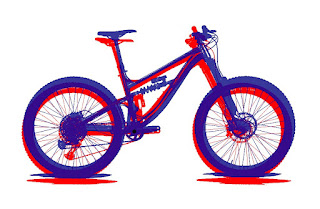Mountain bike geometry is a crucial aspect of how a bike feels and performs on the trail. By understanding key elements like wheelbase, headtube angle, and reach—plus a couple more, like bottom bracket height and chainstay length—you can better match a bike to your riding style and terrain. Here's a breakdown:
1. Wheelbase
The wheelbase is the distance between the front and rear axles. It directly impacts the bike’s length, stability, and maneuverability:
- Shorter Wheelbase: Found on smaller, more playful bikes, it allows for quicker turns and easier maneuvering on tight trails.
- Longer Wheelbase: Typically seen on downhill or enduro bikes, a longer wheelbase provides more stability at high speeds and better performance on steep, rough terrain.
- Why It Matters: A rider who prioritizes stability over agility might prefer a bike with a longer wheelbase, while those tackling technical, twisty trails may opt for shorter.
2. Headtube Angle
This is the angle between the ground and the fork's steerer tube. It defines the bike's steering characteristics and its intended use:
- Slack Headtube Angle (65° or less): Found on downhill and enduro bikes, this angle improves stability and control on steep descents.
- Steep Headtube Angle (67° or more): Common in cross-country bikes, it provides sharper steering and better climbing efficiency.
- All-Around (66°-67°): Ideal for trail bikes that balance climbing and descending performance.
- Why It Matters: A slack headtube angle can make a bike feel sluggish on flatter trails, while a steep one may feel twitchy on descents. Riders should choose based on their primary terrain.
3. Reach
Reach is the horizontal distance from the bottom bracket to the center of the headtube and influences how "roomy" the cockpit feels:
- Shorter Reach: Creates a more upright riding position, better for less aggressive riders or those prioritizing comfort.
- Longer Reach: Provides a more stretched-out position, giving added stability and control on fast descents.
- Why It Matters: Correct reach ensures the rider feels balanced. It’s especially important when choosing between sizes.
4. Bottom Bracket Height
The height of the bottom bracket (BB) relative to the ground impacts center of gravity and pedal clearance:
- Lower BB: Lowers the center of gravity, improving cornering stability. However, it increases the risk of pedal strikes on rough terrain.
- Higher BB: Offers more clearance for technical trails but can make the bike feel less planted.
- Why It Matters: Riders tackling rocky, technical trails may prioritize a higher BB, while flowy-trail riders might enjoy the cornering benefits of a lower BB.
5. Chainstay Length
The chainstay length is the distance between the bottom bracket and the rear axle. It influences the bike's agility and rear-wheel traction:
- Shorter Chainstays: Make the bike feel more playful and easier to manual or corner.
- Longer Chainstays: Improve rear-wheel traction and stability, especially on climbs and high-speed descents.
- Why It Matters: Short chainstays are great for riders looking to pop off features, while longer ones provide a planted feel for tackling rough terrain or long climbs.
Final Thoughts
While wheelbase, headtube angle, reach, bottom bracket height, and chainstay length are some of the most important aspects of bike geometry, they are not the only ones. Other factors, like stack height, seat tube angle, and trail, also play a significant role in how a bike rides. Understanding these elements can help you make informed decisions and find the bike that fits your needs perfectly.

Comments
Post a Comment